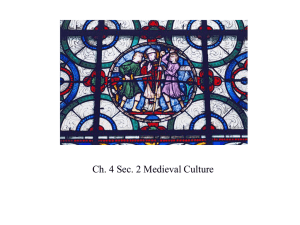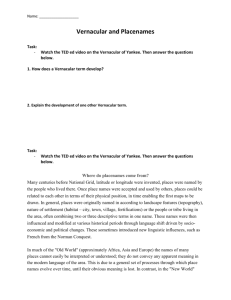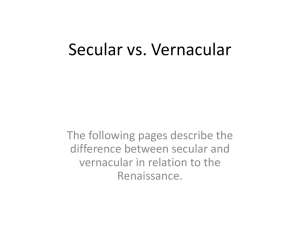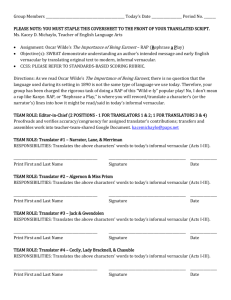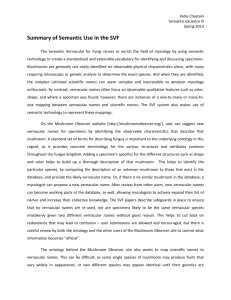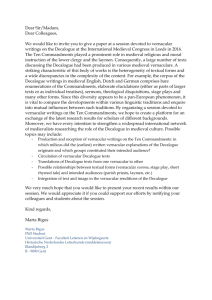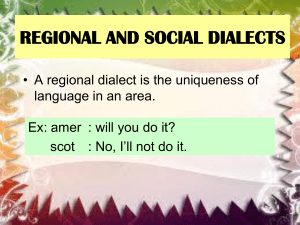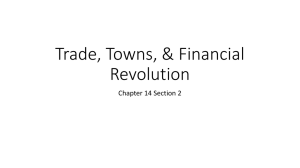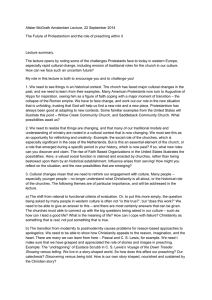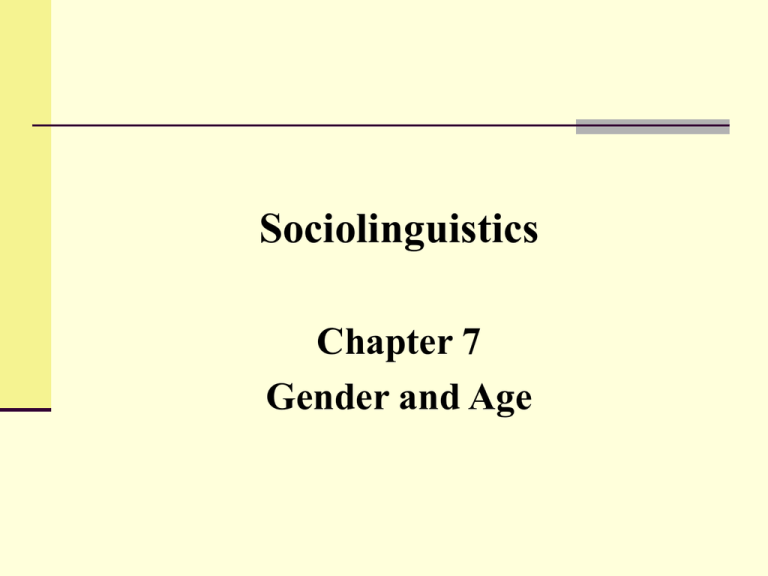
Sociolinguistics
Chapter 7
Gender and Age
Learning Objectives
Gender-exclusive speech differences
Gender-preferential speech features
Gender and social class
Explanation of women’s linguistic behaviour
Age-graded features of speech
Age and social dialect data
Age grading and language change
Gender-exclusive speech differences
Example 1
Amazonian men and women speak different
languages.
Example 2
In Yana, a North American Indian language,
men and women use forms of words.
Gender-exclusive speech differences
Example 3
In Japanese, men and women use different
words.
Further example
In Bengali society, a wife is subordinate and
is not permitted to use her husband’s name.
A Bengali wife therefore addresses her
husband whose name means ‘star’ as
‘heavenly body’.
Exercise 1
Gender-preferential speech features
Instead of using completely different forms of
language in highly structure communities,
men and women in urban communities use
different quantities or frequencies of the same
forms.
Example 4
h-dropping
Further example
In Sydney, men use [f] in words like thing
more often than women.
Gender and social class
The linguistic features which differ in the
speech of women and men are usually
features which also distinguish the speech of
people from different social classes.
Figure 7.1
Vernacular [in] by sex and social group in
Norwich
Gender and social class
In every social class, men use more
vernacular forms than women.
Women’s speech is closer to that of the men
in the same group than to that of women in
other groups. Therefore class membership
seems to be more important than gender
identity.
Gender and social class
Across all social groups, women generally
use more standard forms than men, who use
more vernacular forms.
Pronunciation
Norwich
walking
speaking
Men
vernacular [in]
Women standard [iŋ]
Grammar
Detroit
multiple negation
Men
vernacular
I don’t know nothing about it.
Women standard
I don’t know anything about it.
Vocabulary
Liverpool
Men
vernacular
Women standard
judies
last
rozzers
girls
hopeless
police
Activity 7.1
Do the women and the men speak differently
in your speech community?
Do you see a difference in the use of
standard and vernacular forms?
Explanations for the difference
in language use by gender
The social status explanation
Woman’s role as guardian of society’s
values
Subordinate groups must be polite
Vernacular forms express machismo
The social status explanation
Women use more standard speech forms
than men because they want to claim social
status, especially those who do not have
paid employment.
Counter-argument
In an American study comparing the speech
of women in service operations and that of
women working in the home, women in paid
occupations use more standard forms.
Women’s role as guardian of
society’s values
Society tends to expect ‘better’ behaviour
from women than from men. Therefore they
serve as role models for children’s speech.
Counter-argument
Interactions between a mother and her child
are likely to be very relaxed and informal,
and vernacular forms rather than standard
forms are used.
Subordinate groups must be polite
Women as a subordinate group must speak
carefully and politely, and therefore tend to
use more standard forms.
Counter-argument
Polite speech does not necessarily equate
standard speech.
Example 7
Vernacular forms express machismo
Men prefer vernacular forms because they
carry macho connotations of masculinity and
toughness.
Some alternative explanations
How women are categorised?
The influence of the interviewer and the
context
How women are categorised?
Researchers in early social dialect studies
often used the women’s husband’s
occupation as their major criterion.
Therefore miscategorisation often occurred
and that explained the speech behaviour of
the women.
Example 10
The influence of the interviewer
and the context
The interviewer as a middle-class well-
educated academic
The interviewer as man
The formal context
Gender as the primary factor for
speech variation
Although gender interacts with other social
factors, such as status, class, role of the
speaker in an interaction, formality of the
contexts, etc, there are cases in which
gender is the primary factor accounting for
speech variation.
Examples
Tyneside study Figure 7.2
Reading study
Age-graded features of speech
Use of swear words decreases after people
begin to have children
Slang is the linguistic prerogative of young
people
Activity 7.2
Do you see differences in language use in
different age groups?
Language variation in Hong Kong
Meaning
Standard form
Vernacular
form
我
I
ŋo5
o5
你
you
nei5
lei5
國
country
gwok3
gok3
Age and social dialect data
A common pattern shows that the use of
vernacular forms is high in childhood and
adolescence.
The usage steadily reduces as people
approach middle age when social pressures
to conform are greatest.
Vernacular usage gradually increases again
in old age as social pressures reduce.
Figure 7.3
Figure 7.4 Detroit and Appalachian study
Age grading and language change
Age grading
Language change
Stable variation
Language change in
progress
Bell-shaped pattern
Steady increase or
steady decline


